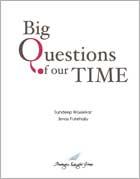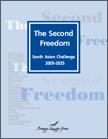Jacob Bronowski, The Ascent of Man
 |
December 2005
By Ilmas Futehally
|
What separates man from other primates, or indeed other animals? Jacob Bronowski, a mathematician trained in physics, examines the scientific and intellectual history of humankind in his book The Ascent of Man. Though the book is based on the television series aired on BBC in the 1970s, it is far from outdated. Over 30 years after it was first published; The Ascent of Man still invokes pride in our past and instils hope for our future in the reader.
Covering a wide canvas from the dawn of man until the modern times, Bronowski examines how man has been the shaper of his surroundings rather than being shaped by it. Every other species has been adapted to fit into a certain ecological niche; they have evolved for a particular environment. Man, despite his comparatively weak physical attributes has been able to shape the world with his unique set of gifts. Bronowski believes that it was not so much biological evolution, but cultural evolution that has made man what he is today.
Tracing the evolution of human from their hunter gather phase to the present one, he says that the change in diet from plant to animal based materials gave humans more time free to spend on building capabilities to get food from sources that could not be tackled by brute force. The most marked effect of this was to foster group action and communication. The next single largest step in the ascent of man was the change from a nomadic way of life to village agriculture, made possible by a set of natural and human events. Settled agriculture creates a technology from which all sciences take off.
Taking the reader on a journey through time, Bronowski delights in the inventions and scientific discoveries made over the last ten thousand years- from the domestication of wheat in 8000 BC to the double helix structure of the DNA in the 1950s. He describes the tools that extend the human hand as an instrument of vision- they reveal new structures and make it possible to put them together in imaginative combinations.
By delving deep into the lives and thoughts of an extraordinary range of people, Bronowski discusses a wider range of complex subjects from Anthropology to Astronomy and from Mathematics to the Life Sciences. He reveals the linkages that bring together cultures by introducing us to Pythagoras, who found a basic relation between musical harmony and mathematics, Euclid, Ptolemy and Arab scholars who delighted in calculation and geometry. The author demonstrates how the spread of ideas along the trade routes - the spread of the numeral system for notation of numbers from the Arab world and the decimal system from India - changed mathematics forever.
From mathematics to astronomy is a logical step. The Mayan civilization housed their astronomers in pyramid like structures and developed calendars to trace the journey of the stars, Copernicus placed the sun at the centre of the planetary system and Galileo gave his life to prove that this was so. The lives of these people have a profound impact on the modern way of life. While no account of the ascent of man can leave out Isaac Newton and Albert Einstein, Bronowski describes more than their work. He shows us how they thought and how their characters defined their work.
The Industrial Revolution was the greatest discoverer of power- a time when new sources of energy were discovered and used. With this came many of the characteristics of the modern world that we abhor- the factory system with inhuman work hours, tyrannical bosses, pollution and the domination of men by machines. While bringing these to our notice, Bronowski does not leave out the other side of this age - the delight of discovery and the sense of fun in finding new ways of doing things. He believes that this revolution is as important as the Renaissance in the ascent of man- while one established the dignity of man; the other established the unity of nature.
Describing the theory of evolution by natural selection put forward by Charles Darwin and Alfred Wallace, Bronowski says that it was the most important single scientific innovation of the nineteenth century. It shows that the world is in movement and that creation is not static; it changes with time unlike the physical world. Another discovery that has shaped biology is one by contemporary scientists, which express the cycle of life in a chemical form that links them to nature as a whole.
Turing to the physical sciences, Bronowski says that the aim of the physical sciences has been to give an exact picture of the material world. One achievement of physics in the twentieth century has been to prove that aim is unattainable! Physicists have shown that there is no absolute knowledge; all information is imperfect and we have to treat it with humility.
In the last chapter in book, titled The Long Childhood, Bronowski goes back to what makes man human and what has made the ascent of man possible. He says, �€œWe are all afraid - for our confidence, for the future, for the world. That is the nature of the human imagination. Yet every man, every civilization has gone forward because of its engagement with what it has set itself to do. The personal commitment of man to his skill, the intellectual commitment and the emotional commitment working together as one, has made the Ascent of Man.�€
Related Publications
-
.jpg&maxw=50)
Big Questions of Our time: The World Speaks, 2016
Download:Big Questions of Our time: The World Speaks _Full Report
-

-

Second Freedom South Asian Challenge 2005-2025, 2005
read more
Download:Second Freedom South Asian Challenge 2005-2025 Full Report
Related latest News
Related Conferences Reports
-

Global Challenges Conference, October 2016
Download:Global Challenges Conference Report
-

Conference on Responsibility to the Future: Business, Peace and Sustainability, June, 2008
Download:Global Security and Economy: Emerging Issues


